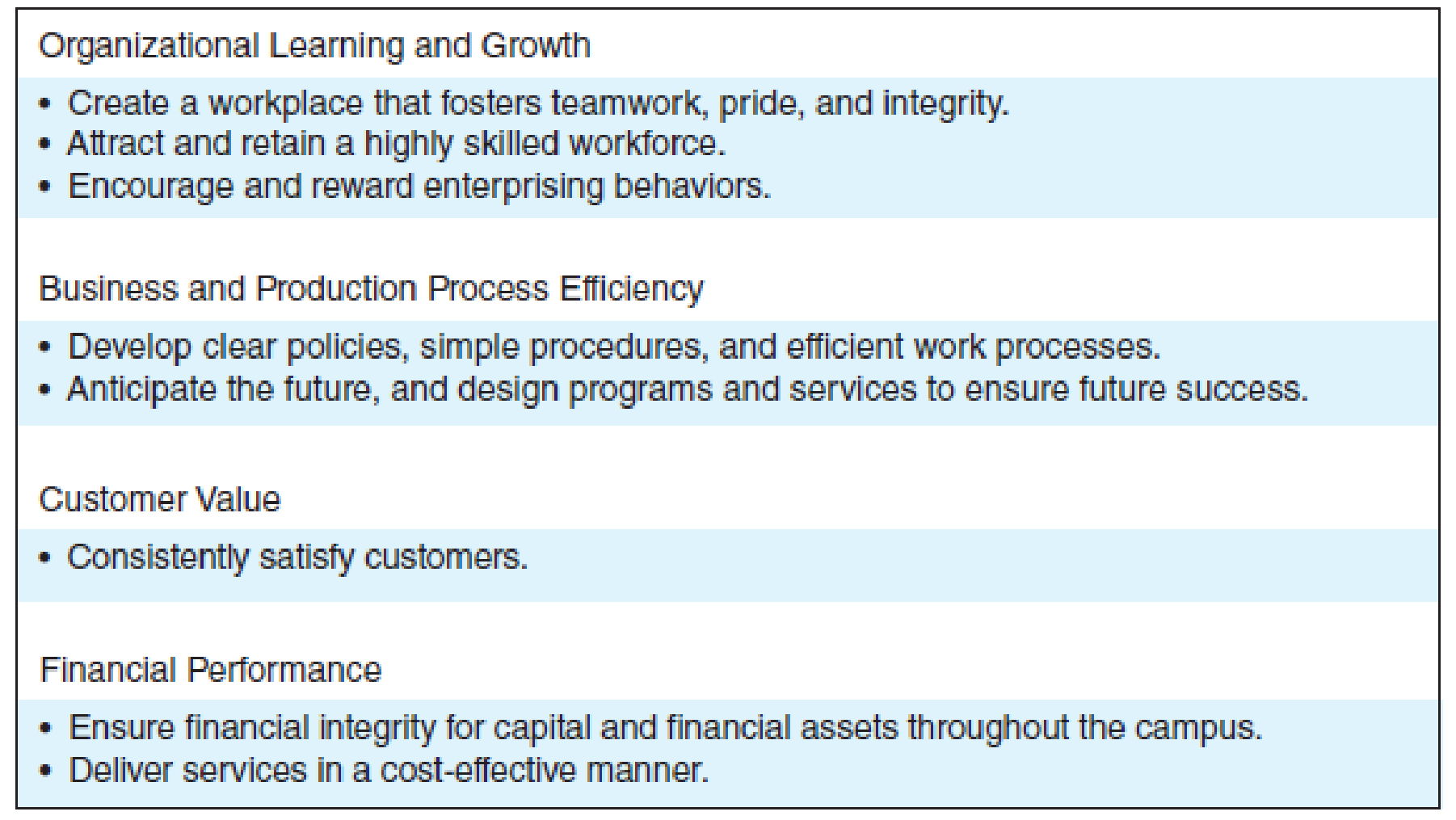
Concept explainers
Balanced Scorecards and Strategy Maps
Following several years of tight budgets, administrators at the University of California, Davis, looked for ways “to do more with less.” Janet Hamilton, vice chancellor of administration, researched books and articles, met with consultants, and talked to her counterparts at universities across the United States to find new management methods that could change the university from a bureaucratic organization to one that is customer-oriented. She learned about reengineering, total quality, and a variety of other management techniques. None of the management techniques appealed to her, until she came across articles about the balanced scorecard. She believed that the balanced scorecard was the right tool for the Davis campus, and she set about implementing it.
At first, Hamilton did not call her approach a “balanced scorecard,” because she feared that employees would think of this as just another management fad to endure until the administration went on to something new. Instead, she pilot-tested the balanced scorecard ideas in one service department, environmental health and safety (EHS), until it worked. With the success of EHS behind her, she moved to implement the balanced scorecard in other service departments, such as police, fire, and printing services.
Each department developed its own particular performance measures to achieve the following objectives (we have shortened the list to save space):

Required
- a. Was the vice chancellor overly cautious in not calling her approach a “balanced scorecard”?
- b. Comment on the wisdom of beginning a balanced scorecard with a pilot project. Would it be possible to extrapolate the experience of a service department, such as environmental health and safety, to an academic unit, such as a college of business?
- c. What opportunities and difficulties do you see in applying a balanced scorecard to a university setting?
Want to see the full answer?
Check out a sample textbook solution
Chapter 18 Solutions
FUNDAMENTALS OF...(LL)-W/ACCESS>IP<
- Degregorio Corporation makes a product that uses a material with the following direct material standards: Standard quantity 2.7 kilos per unit Standard price $9 per kilo The company produced 5,700 units in November using 15,760 kilos of the material. During the month, the company purchased 17,830 kilos of direct material at a total cost of $156,904. The direct materials purchases variance is computed when the materials are purchased. The materials quantity variance for November is: a. $3,330 F b. $3,236 F c. $3,330 U d. $3,236 Uarrow_forwardNonearrow_forwardGeneral Accountarrow_forward
- Financial accountingarrow_forwardSubject: Financial Accountingarrow_forwardThe blending department had the following data for the month of March: Units in BWIP Units completed 7,200 Units in EWIP (40% complete) 750 $27,000 Total manufacturing costs Required: 1. What is the output in equivalent units for March? 2. What is the unit manufacturing cost for March?arrow_forward
 Cornerstones of Cost Management (Cornerstones Ser...AccountingISBN:9781305970663Author:Don R. Hansen, Maryanne M. MowenPublisher:Cengage LearningPrinciples of Accounting Volume 2AccountingISBN:9781947172609Author:OpenStaxPublisher:OpenStax College
Cornerstones of Cost Management (Cornerstones Ser...AccountingISBN:9781305970663Author:Don R. Hansen, Maryanne M. MowenPublisher:Cengage LearningPrinciples of Accounting Volume 2AccountingISBN:9781947172609Author:OpenStaxPublisher:OpenStax College Managerial AccountingAccountingISBN:9781337912020Author:Carl Warren, Ph.d. Cma William B. TaylerPublisher:South-Western College Pub
Managerial AccountingAccountingISBN:9781337912020Author:Carl Warren, Ph.d. Cma William B. TaylerPublisher:South-Western College Pub Financial And Managerial AccountingAccountingISBN:9781337902663Author:WARREN, Carl S.Publisher:Cengage Learning,
Financial And Managerial AccountingAccountingISBN:9781337902663Author:WARREN, Carl S.Publisher:Cengage Learning,



